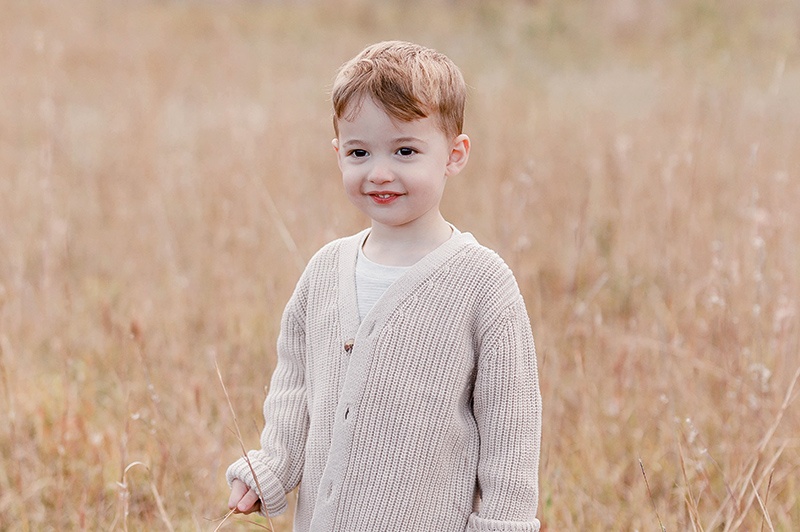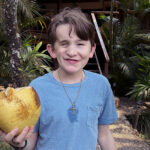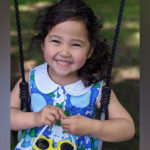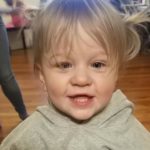All in it for Hudson: A family’s shared path with cavernous malformations

Three-year-old Hudson loves trucks and PAW Patrol. He’s a delightful blend of sweet, fun, and feisty, and — after a seizure on New Year’s Day led to an extended stay at Boston Children’s Hospital — he’s an inspiration to his parents, Gabrielle and Matthew. To Matthew specifically, Hudson provides a new look at his own health history.
“I had a sudden seizure that led to brain surgery when I was 14,” Matthew says. “Doctors thought it was an AVM at the time, but after what happened to Hudson, we are reevaluating that diagnosis. We think now that what I had was a cavernous malformation, the same as my son, and that we have a hereditary predisposition to them.”
Matthew and Gabrielle credit the Cerebrovascular Surgery and Interventions Center (CSIC) for saving their son, uncovering answers about Matthew’s own health, and helping navigate what it may mean for their family.
A New Year’s Day discovery leads to a new diagnosis
It was Hudson’s 7-year-old sister, Hazel, who alerted Gabrielle and Matthew to Hudson lying on his bedroom floor. Gabrielle remembers the whirlwind of that moment, arriving at the ER near their home just south of Boston, and being quickly transferred to Boston Children’s.

“He perked after a while in the ER,” Gabrielle says. “He seemed totally fine. So, when the staff came in and said, ‘There’s bleeding in his brain; you’re going to Boston Children’s,’ I remember being so shocked.”
At Boston Children’s, a MRI showed multiple cavernous malformations — clusters of abnormally enlarged blood vessels in the brain, one of which had hemorrhaged and caused his seizure, and four that were dormant. In addition, EEG results showed that Hudson was also experiencing nearly 100 subclinical (non-visible) seizures a day. The family met with Dr. Alfred See and other members of the CSIC team, including nurse practitioner Christopher Isibor, to discuss the best path forward.
A comfortable and safe environment
Dr. See and Chris hit it off with Hudson right away.
“They talked to Hudson at the same level they talked to us,” Matthew says. “Hudson responded really well to them.”
Dr. See and Chris also made an impression on Gabrielle and Matthew, putting them at ease and helping them feel good about each next step.
“They were so relaxed,” Matthew adds. “It was clear Dr. See was an expert. We were entrusting our son to him, and we felt like if he couldn’t fix this, nobody could.”
Surgery to remove the cavernous malformation was scheduled for two weeks out. The focus in those two weeks was alleviating the swelling in Hudson’s brain and reducing his seizures. This required constant monitoring as they tried various medications, so Hudson stayed at Boston Children’s. He made fast friends with the staff and spent most of his time driving a toy fire truck throughout the hospital.
“He was calling it his home by the end,” Matthew says. “That’s a testament to Boston Children’s and how they created an environment he felt comfortable and safe in.”
On January 16, Dr. See successfully removed the affected brain tissue. Two days later, Hudson was able to go home. Today, Hudson’s on anti-seizure medication and hasn’t experienced a clinical (visible) seizure. Follow-up EEGs have shown no signs of subclinical seizures, either.
Finding genes and making plans
From the onset, Dr. See and the CSIC team were pretty confident that Hudson’s cavernous malformations were the result of a genetic condition, especially given that he had multiple simultaneously.
With Matthew and Gabrielle’s consent, the team provided a tissue sample taken during Hudson’s surgery for genetic testing. The results showed a mutation in the CCM2 gene, which helps make a protein that keeps blood vessels in the brain and other parts of the body healthy. Mutations in CCM2 indicate a heightened risk of cavernous malformations. Gabrielle and Matthew have now expanded genetic testing to the rest of their family, including Hazel. The results will help inform their future health and care needs decisions, including routine monitoring. For Hudson, this means regular MRIs as well as appointments with ophthalmologist Dr. Pablo Altschwager Kreft and the Dermatology Program to watch for malformations that may form on his eyes or skin.
Gabrielle and Matthew are also working with the CSIC team to set up developmental testing down the road to evaluate how and if Hudson’s cognitive function has been impacted.
Preparing for the future
While they work through the genetic testing process, Matthew and Gabrielle remain grateful that Hudson is home and happy, that Hazel shows no signs of cavernous malformations, and that there are plans in place to ensure both children have the resources they may need as they grow and develop. They also remain in awe of their son and all he’s endured.
“He’s not afraid of much,” Matthew says. “He’s been through a lot at a young age, but he’s got a big life in front of him.”
Learn more about the Cerebrovascular Surgery and Interventions Center at Boston Children’s Hospital or request an appointment.
Related Posts :
-

Defying the odds: Cruise’s triumph against cavernous malformations and debilitating headaches
As a toddler, Cruise — now 13 — faced a rare cancer diagnosis that came with an 11 percent chance of survival. But with ...
-

Like father, like daughter: Finding care for cavernous malformations
After Charlotte Miller underwent neurosurgery, her parents, Daniel and Eliza were a little nervous to tell her that part of ...
-

Sharing our journey with cavernous malformations
Finley and her twin sister, Rowan, were born seven weeks premature on November 7, 2017 in Scranton, Pennsylvania. In July 2019, Finley was ...
-

Thinking – and operating – outside the box: Bypassing Saoirse’s aneurysm
Saoirse just turned 3. There was a big to-do for her birthday, complete with family flying to Massachusetts from Ireland for ...





